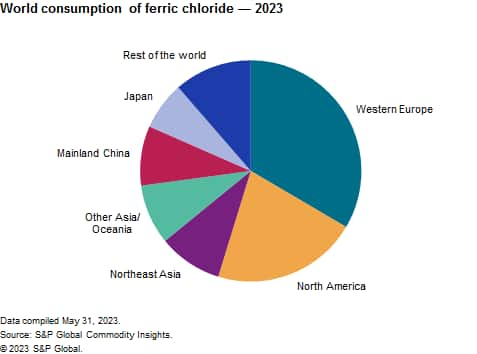Published July 2023
The primary use of ferric chloride is to remove impurities in water and for wastewater treatment. Ferric chloride is also one of the few water treatment chemicals that can sequester odors. Combined with use in industrial water applications and in the pretreatment of seawater prior to desalination, total water treatment accounts for more than three-fourths of total demand globally. Smaller volumes of higher-grade ferric chloride are used as a catalyst in chemical reactions and as an etchant in microelectronics production (printed circuit boards [PCBs]). The PCB market is largely in Asia.
The following pie chart shows world consumption of ferric chloride:

The ferric chloride market is mostly regional, because transportation of the ferric chloride solution is uneconomical. The markets in industrialized countries are mature, whereas demand in developing countries keeps growing with the increasing demand for water treatment, and more stringent regulations for the treatment of industrial wastewater. Although it is recognized as a highly effective flocculant and sequestering agent for sludge and odor control, substitution from competing products will lead to relatively flat demand growth.
Global production capacities exceed demand significantly. Nameplate capacities are often larger than regional demand, which allows producers to vary production volumes opportunistically, and as a function of by-product availability and the price of hydrochloric acid. No new uses for ferric chloride are on the horizon, nor are there other products likely to replace ferric chloride in its main areas of use.
For more detailed information, see the table of contents, shown below.
S&P Global’s Chemical Economics Handbook – Ferric Chloride is the comprehensive and trusted guide for anyone seeking information on this industry. This latest report details global and regional information, including

Key benefits
S&P Global’s Chemical Economics Handbook – Ferric Chloride has been compiled using primary interviews with key suppliers and organizations, and leading representatives from the industry in combination with S&P Global’ s unparalleled access to upstream and downstream market intelligence and expert insights into industry dynamics, trade and economics.
This report can help you
- Identify trends and driving forces influencing chemical markets
- Forecast and plan for future demand
- Understand the impact of competing materials
- Identify and evaluate potential customers and competitors
- Evaluate producers
- Track changing prices and trade movements
- Analyze the impact of feedstocks, regulations and other factors on chemical profitability


















